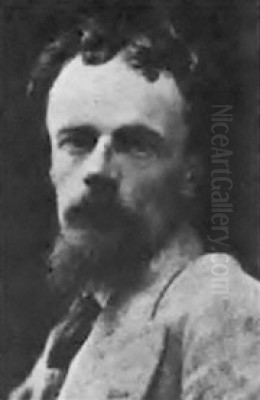
John Atkinson Grimshaw stands as one of the most distinctive and atmospheric painters of the Victorian era. A largely self-taught artist from the north of England, he carved a unique niche for himself with his evocative depictions of moonlit urban landscapes, docksides, and suburban lanes. His work captures the specific mood of late 19th-century Britain, blending realism with a haunting, poetic sensibility. Though sometimes overlooked during periods when bolder, more experimental art forms took centre stage, Grimshaw's meticulous technique and mastery of light have ensured his enduring appeal and recognition as a significant figure in British art history.
Early Life and Artistic Awakening
John Atkinson Grimshaw was born in Leeds, Yorkshire, on September 6, 1836. His early life gave little indication of his future artistic path. His father worked as a policeman, a profession far removed from the art world. Furthermore, his mother actively disapproved of his artistic inclinations, viewing such a career as impractical and insecure. Following a conventional route, Grimshaw initially took up employment as a clerk for the Great Northern Railway.
However, the pull towards art proved irresistible. In 1861, at the age of 24, Grimshaw made the bold decision to resign from his secure railway job to dedicate himself entirely to painting. This was a significant risk, especially for a young man without formal artistic training and facing parental opposition. His early works focused on subjects readily available to him, including detailed studies of birds, fruit, and blossoms, often painted with a precision that hinted at his later meticulous style.
Developing a Unique Vision: The Nocturne
While his initial subjects were conventional, Grimshaw soon found his true calling in landscape and, particularly, cityscape painting. He became fascinated by the effects of light, especially the subtle and transformative qualities of moonlight and twilight. This led him to develop his signature style: the nocturne. He specialized in depicting urban and suburban scenes under the cloak of evening or night, often illuminated by the silvery glow of the moon, the warm, inviting light spilling from windows, or the starker illumination of gas lamps.
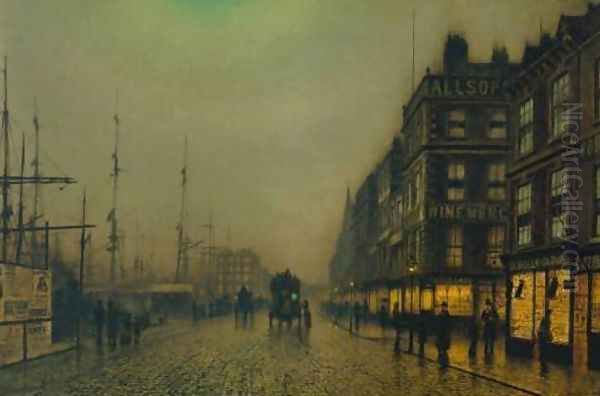
Grimshaw possessed an extraordinary ability to capture atmosphere. His paintings often feature damp, rain-slicked streets reflecting the available light, creating a sense of quiet melancholy or romantic stillness. He masterfully rendered the nuances of weather – mist, fog, rain, the crisp air of autumn – embedding his scenes with a palpable sense of time and place. His use of precise colour and fine detail, combined with the dramatic interplay of light and shadow, lent his works an almost dreamlike, ethereal quality, transporting the viewer into the heart of the Victorian night.
Influences and Techniques
As a self-taught artist, Grimshaw absorbed influences from various sources. His early detailed style shows a clear affinity with the principles of the Pre-Raphaelite Brotherhood, who advocated for 'truth to nature' and meticulous rendering. Artists like William Holman Hunt and William Henry Wallis, known for their intense detail and often moralising subjects, represent the broader artistic climate Grimshaw initially responded to. The influential critic John Ruskin, a champion of the Pre-Raphaelites and advocate for close observation of nature, also appears to have impacted Grimshaw's early approach, particularly his commitment to detailed representation.
Grimshaw was also influenced by the Leeds landscape painter John William Inchbold, whose work similarly displayed Pre-Raphaelite precision. However, Grimshaw developed techniques that were distinctly his own and somewhat unconventional for the time. He is known to have used optical devices, such as the camera obscura or lenses, to project scenes onto his canvas. This practice, sometimes viewed with suspicion by contemporaries who valued freehand drawing skills above all, allowed Grimshaw to achieve remarkable accuracy in perspective and detail, particularly in complex architectural scenes. It also aided his exploration of light effects, contributing to the photographic clarity found in many of his works.
While influenced by realism, Grimshaw's work stands apart from the burgeoning Impressionist movement, exemplified by artists like Claude Monet or Camille Pissarro, who were more concerned with capturing fleeting moments and the subjective experience of light through broken brushwork. Grimshaw maintained a tighter, more finished style, focusing on the mood and atmosphere inherent in the scene itself.
Urban Landscapes and the Victorian City
Grimshaw's most celebrated works are his depictions of the burgeoning towns and cities of Victorian Britain. He painted the streets, docks, and suburban lanes of Leeds, Liverpool, London, Glasgow, Hull, and Scarborough. His fascination with docksides is particularly notable, capturing the forest of masts, the reflections in the water, and the glow of lights from ships and harbour buildings. These scenes often convey the scale and activity of Britain's maritime and industrial power during the era.
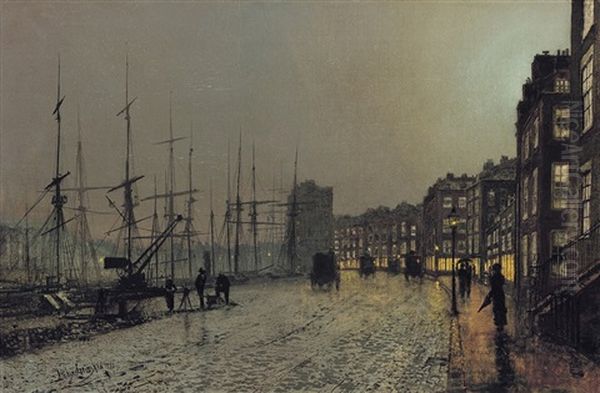
His paintings provide a unique visual record of the Victorian urban environment – the gaslit streets, the horse-drawn cabs, the solitary figures walking through the night. Yet, they are more than mere topographical records. Grimshaw imbued these scenes with a powerful sense of mood, often evoking feelings of solitude, mystery, or quiet contemplation. The lone figures frequently present in his work enhance this sense of introspection amidst the sprawling city. His work captures both the progress and the potential alienation of the Industrial Revolution's impact on the urban landscape.
Connections and Contemporaries
Despite being largely self-taught and based primarily in the North of England for much of his career, Grimshaw did have connections within the wider art world. During time spent in London, he came into contact with John Ruskin and John William Inchbold. Perhaps his most famous artistic connection was with the American expatriate artist James McNeill Whistler.
Whistler, himself renowned for his atmospheric nocturnes, particularly of the Thames, encountered Grimshaw's work. There's a well-known, possibly apocryphal, anecdote where Whistler remarked, "I considered myself the inventor of Nocturnes until I saw Grimmy's moonlights." While the direct nature of their interaction is debated, it's clear there was mutual awareness and perhaps influence. Grimshaw rented a studio in Chelsea, near Whistler's, for a period, and some of Grimshaw's London scenes, particularly his Thames views, show an affinity with Whistler's tonal harmonies and compositional approaches. The influence may have flowed both ways. Grimshaw also appears to have been influenced by the society painter James Tissot.
While directly influenced by the Pre-Raphaelites, there's no strong evidence of close personal ties with the core members like Dante Gabriel Rossetti or John Everett Millais. Grimshaw largely operated outside the main London-centric art circles dominated by figures like Frederic Leighton or Lawrence Alma-Tadema, yet his unique vision gained him considerable recognition. His work can also be seen in the context of earlier British landscape painters like J.M.W. Turner, who also masterfully explored light and atmosphere, albeit in a vastly different, more Romantic style.
A Life in Art: Successes and Struggles
In 1858, Grimshaw married his cousin, Frances Theodosia Hubbard. Their family life was marked by both joy and sorrow; they had twelve children, but tragically, only six survived to adulthood. Four of his surviving children – Arthur E. Grimshaw, Louis H. Grimshaw, Wilfred Grimshaw, and Elaine Grimshaw – followed in their father's footsteps and became painters themselves, sometimes working in styles reminiscent of his own.
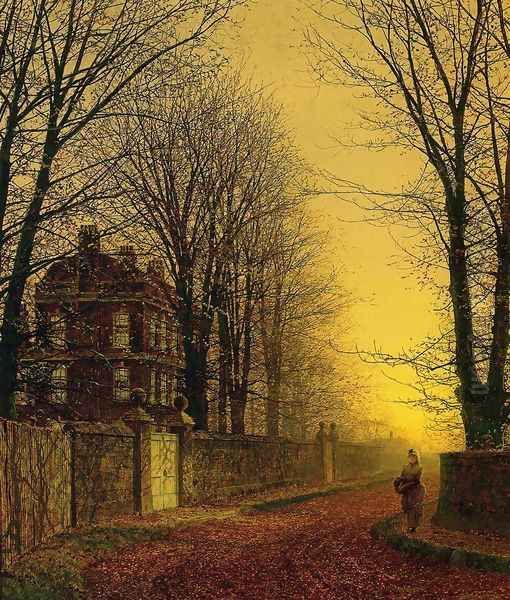
Despite achieving considerable popularity and commercial success during his lifetime, Grimshaw's financial situation was often precarious. He enjoyed periods of prosperity, enabling him to rent Knostrop Hall, a Jacobean mansion near Leeds, which featured in several of his paintings (like Dulce Domum). However, he also faced significant financial difficulties later in life, leading to the sale of property to cover debts. His final years were spent working hard to maintain his income, eventually passing away in Leeds.
John Atkinson Grimshaw died of tuberculosis on October 13, 1893, at the age of 57. He left behind a substantial body of work that continued to be appreciated by collectors even as artistic tastes shifted towards modernism.
Representative Works
Grimshaw's oeuvre is consistent in its themes and preoccupations, yet several works stand out as particularly representative of his talent:
Liverpool Quay by Moonlight (1887): A quintessential Grimshaw dock scene, showcasing his mastery of reflections on wet surfaces and the complex interplay of moonlight and artificial light sources against the silhouettes of ships and buildings.
Shipping on the Clyde (1881): Capturing the industrial might and atmospheric conditions of Glasgow's busy waterway, this painting exemplifies his ability to find beauty and mood in industrial landscapes.
Moonlight on the Thames (1880): Likely painted during his time in London, this work invites comparison with Whistler's nocturnes, yet retains Grimshaw's characteristic detail and specific rendering of light.
On Hampstead Hill: Depicting a more suburban London scene, this work often features solitary figures on gaslit lanes, evoking a sense of quiet mystery and the encroaching presence of the city.
Dulce Domum (Sweet Home): Often depicting Knostrop Hall, these paintings convey a sense of warmth, domesticity, and security, with light spilling invitingly from windows into the moonlit grounds.
Autumn Gold: This title, often applied to paintings featuring autumnal lanes, highlights his skill in capturing seasonal colour and the specific quality of light during different times of the year, typically featuring golden leaves under moonlight.
The Harbour Flare: Likely depicting a scene from Scarborough or another coastal town, this work would focus on the dramatic effect of a signal flare against the night sky and water, showcasing his interest in varied light sources.
Liverpool Lights: Another variation on his famous Liverpool dock scenes, emphasizing the myriad points of light – from ships, buildings, and lamps – reflected in the water.
These works, among many others, demonstrate Grimshaw's consistent focus on light, atmosphere, and the specific character of Victorian Britain's urban and suburban environments.
Market Recognition and Legacy
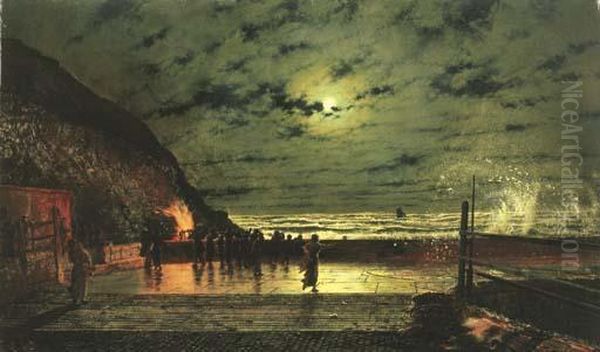
While Grimshaw enjoyed popularity during his lifetime, his critical standing waned somewhat in the early 20th century with the rise of modern art movements. However, a resurgence of interest in Victorian art from the mid-20th century onwards led to a reappraisal of his work. Today, John Atkinson Grimshaw is highly regarded and considered one of the most important painters of nocturnal scenes in British art history.
His works perform strongly in the art market. Auctions consistently see high demand for his paintings, particularly the moonlit cityscapes and dock scenes. Prices can vary depending on size, subject, and condition, but major works frequently achieve six-figure sums in pounds sterling. For instance, Liverpool Lights sold for £280,000, exceeding its estimate. The Harbour Flare achieved £204,650, and In the Pleasure Ground sold for £288,000. A work titled Autumn Gold reached £322,480. Sell-through rates at auction are often high, indicating sustained collector interest. This market strength reflects his established position and the unique appeal of his atmospheric paintings.
Grimshaw's legacy lies in his creation of a highly personal and evocative vision of the Victorian world. He captured the specific mood of gaslit streets and moonlit harbours with unparalleled skill, transforming ordinary urban scenes into images of haunting beauty and quiet reflection. As a master of light and atmosphere, his work continues to resonate with viewers today, offering a compelling glimpse into the nocturnal heart of the 19th century.
Conclusion
John Atkinson Grimshaw's journey from railway clerk to celebrated artist is a testament to his singular vision and dedication. Without formal training, he honed a distinctive style that captured the essence of Victorian Britain's nights like no other artist. His meticulous technique, combined with an extraordinary sensitivity to light and atmosphere, allowed him to create works that are both realistic depictions and poetic interpretations. From the bustling, mist-shrouded docks of Liverpool to the quiet, moonlit lanes of suburban London, Grimshaw's paintings offer an enduring and evocative window onto a bygone era, securing his place as a unique and important figure in the history of British art.